VPN server for remote clients using IKEv1 XAUTH with PSK
Using XAUTH PSK is the least secure mode of running IKE/IPsec. The reason is that everyone in the "group" has to know the PreShared Key (called PSK or secret). Even if you require further authentication, such as a username and password, someone that knows the PSK can launch a man-in-the-middle attack pretending to be the VPN server, If the client connects to the rogue server, it will tell the attacker their username and password.
On Android, this mode is called PSK XAUTH. On iOS/OSX this mode is confusingly called of type "IPSec". some other vendors call it "Group PSK".
It is also possible (and more secure) to use XAUTH with Certificates - seeVPN_server_for_remote_clients_using_IKEv1_XAUTH_with_Certificates
XAUTH PSK
Supported clients:
- All Apple iphones, ipads
- Mac OSX
- Android
- Linux with NetworkManager or commandline
- Microsoft Windows using a third party client such as the Cisco client, or the free Shrew Soft client
It is based on draft-ietf-ipsec-isakmp-xauth-06. XAUTH also requires a username and password. The password can also contain a one time password (OTP) such as Google Authenticator
Server ipsec.conf for XAUTH/PSK
This configuration example uses Main Mode and not Aggressive Mode, as it is more portable and you can use a single conn on the server for Android, iOS/OSX and Linux clients.
# libreswan /etc/ipsec.conf configuration file
config setup
protostack=netkey
# exclude networks used on server side by adding %v4:!a.b.c.0/24
virtual-private=%v4:10.0.0.0/8,%v4:192.168.0.0/16,%v4:172.16.0.0/12,%v4:25.0.0.0/8,%v4:!10.231.247.0/24,%v4:!10.231.246.0/24
# PSK clients can have the same ID if they send it based on IP address.
uniqueids=no
conn xauth-psk
authby=secret
pfs=no
auto=add
rekey=no
left=%defaultroute
leftsubnet=0.0.0.0/0
rightaddresspool=10.231.247.10-10.231.247.254
right=%any
# make cisco clients happy
cisco-unity=yes
# address of your internal DNS server
modecfgdns=10.231.247.1
# versions up to 3.22 used modecfgdns1 and modecfgdns2
#modecfgdns1=10.231.247.1
leftxauthserver=yes
rightxauthclient=yes
leftmodecfgserver=yes
rightmodecfgclient=yes
modecfgpull=yes
#configure pam via /etc/pam.d/pluto
xauthby=pam
# xauthby=alwaysok MUST NOT be used with PSK
# Can be played with below
#dpddelay=30
#dpdtimeout=120
#dpdaction=clear
# xauthfail=soft
ikev2=never
The PSK needs to be stored in /etc/ipsec.secrets (or a separate file such as /etc/ipsec.d/xauth-psk.secrets)
# The first IP is the real IP address of the server 111.222.111.222 %any : PSK "ExampleSecret" # If this is the only IP and only PSK based configuration, you can configure without hardcoding the IP: : PSK "ExampleSecret"
In this example, the IP pool is 10.231.247.0/24 so on the VPN server you would need to provide some NAT rules if you wish to offer full internet connectivity through the VPN. Assuming that your office servers behind this VPN server uses 10.231.246.0/24, you would add the following iptables rules
on the VPN server:
# Note: you should replace $INTERNET_INTERFACE with your internet facing interface. # Note: this line handles maquerade for both 10.231.246.0/24 and 10.231.247.0/24 iptables -t nat -A POSTROUTING -s 10.231.246.0/23 -o $INTERNET_INTERFACE -m policy --dir out --pol none -j MASQUERADE
Client ipsec.conf XAUTH/PSK
There are some small differences with the above server configuration
conn xauth-psk
authby=secret
left=%defaultroute
leftxauthclient=yes
leftmodecfgclient=yes
leftxauthusername=YOURUSERNAME
modecfgpull=yes
right=REMOTESERVERNAME
rightxauthserver=yes
rightmodecfgserver=yes
rekey=no
#dpdaction=hold
#dpdtimeout=60
#dpddelay=30
auto=add
# Commonly needed to talk to Cisco server
# Might also need _exact_ ike= and esp= lines
# remote-peer-type=cisco
# aggrmode=yes
# one of thesse two
# rightid=@[GroupName]
# rightid=@GroupName
You need to store the Group PSK into a secrets file (/etc/ipsec.secrets or your own /etc/ipsec.d/xauth-psk.secret). You can also store your XAUTH password in /etc/ipsec.secrets if you do not use NetworkManager and if you're not using a one time token:
# /etc/ipsec.secrets REMOTESERVERNAME %any : PSK "YourGroupPSK" @YOURUSERNAME: XAUTH "YourPassword"
When using PSK instead of RSA/certificates, you require the "GroupPSK" which is the XAUTH secret, and also need to use leftid=@GroupID instead of using the ID of your certificate.
You can bring the connection up using the comnmand: ipsec auto --up xauth-psk This will automatically reconfigure your DNS if required, and configure the given IP address on your system.
Server options
Aggressive Mode
The difference between using the regular Main Mode or Aggressive Mode for the client is usually determined by whether or not the "Group Name" is set. On Android, this option is called "IPSec identifier". On iOS/OSX and NetworkManager this fiels is called "Group Name". When these fields are blank, Main Mode (preferred) is used. When these are not blank, Aggressive Mode is used. On the serverside, the Group Name is the value of the rightid=@String (the remote end, not the server end). Unfortunately, iOS/OSX sends these as hex, which can be matched using rightid=@[String] but then it no longer works for Android. With NetworkManager you can specify "String" or "[String]". These values are best left unset when using libreswan as a server, so that Main Mode is used. When connecting to a Cisco with libreswan as a client, you will need to use rightid=@String and aggrmode=yes.
| iOS UserInterface bug: If you ever fill in the "Group Name" and then clear it - the connection remains using Aggressive Mode. If you want to use Main Mode your only choice is to delete the VPN profile and start one from scratch where you never touch the "Group Name" input box. |
User/password authentication for XAUTH on the server
Libreswan has three options for the user/password authentication. This is specified using the xauthby= option. If using X.509 certificates, which are issued to individual devices/users and which can be revoked, there is no real need to have an additional username/password layer. In that case, xauthby=alwaysok can be used. This should not be used when using a PSK.
If there are only a handful of users that need to be authenticated, xauthby=file can be used. The format of this file is similar to the Apache htpasswd file, but the htpasswd command can not be used to create the file. The differences to htpasswd format is pluto uses standard crypt hashing which is same as /etc/shadow format so sha2_512 can be used. Additional third column specifying the connection name. An example of an /etc/ipsec.d/passwd file for the above example connection (using xauthby=file) would be:
john:$1$5h/bAg4p$Q5/c2XjwSzYy3sh/1j8Bp/:xauth-psk paul:$1$YiVSo114$um2oIM6AqucFuMeXl/1ab0:xauth-psk
The last method that can be used is xauthby=pam. Using this configuration, libreswan uses the /etc/pam.d/pluto pam configuration file to authenticate users. An /etc/pam.d/pluto example file:
#%PAM-1.0 # Regular System auth auth include system-auth # # Google Authenticator with Regular System auth in combined prompt mode # (OTP is added to the password at the password prompt without separator) # auth required pam_google_authenticator.so forward_pass # auth include system-auth use_first_pass # # Common account required pam_nologin.so account include system-auth password include system-auth session optional pam_keyinit.so force revoke session include system-auth session required pam_loginuid.so
xauthfail= option
Some deployments wish to catch the user when their password is wrong or disabled and notify them. When the option xauthfail=soft is set, the authentication failure is ignored and the IPsec tunnel is allowed to establish. The "updown" script is signaled with the environment variable XAUTHFAIL=soft. This can be used to NAT this user to a specific web page where they can renew their VPN subscription.
ike-frag= option
It is recommended to use the ike-frag=yes option to make the IKE connection more reliable. This is particularly important when using X.509 certificates, which tend to cause fragmentation when used with 2048 bit RSA keys.
NetworkManager-libreswan client
These are some screenshots of the NetworkManager libreswan client to configure XAUTH PSK. Note that until very recently (February 2016), NetworkManager only supported using Aggressive Mode and the Group Name field could not be left empty. If you see this happening, please upgrade your NetworkManager-libreswan (or NetworkManager-openswan) plugin.
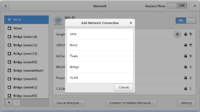
|
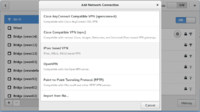
|

|
iPhone and iPad client
Go to Settings and select VPN. Click on Add VPN Configuration. select type IPSec. Fill in the description, server (name or IP), Account (aka username), Password and Secret (aka PSK). For PSK connection you MUST NOT enter a Group Name.
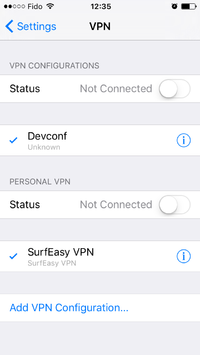
|
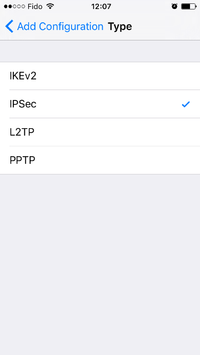
|
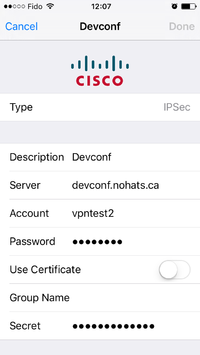
|